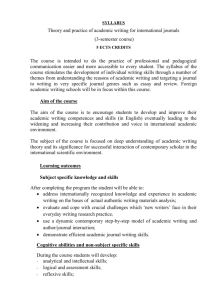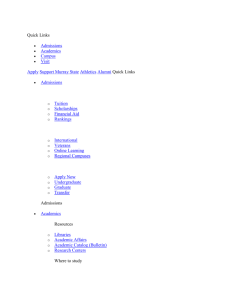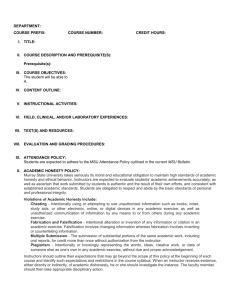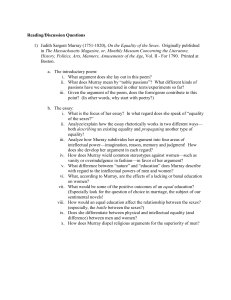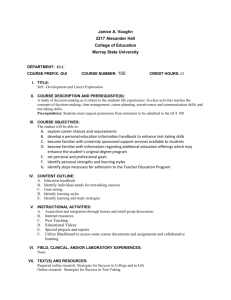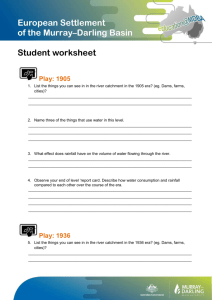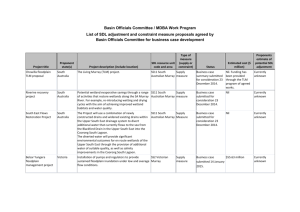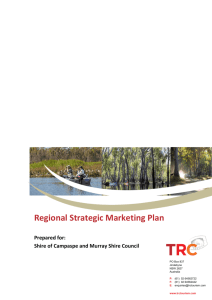Murray Regional Tourism - the Department of Economic
advertisement
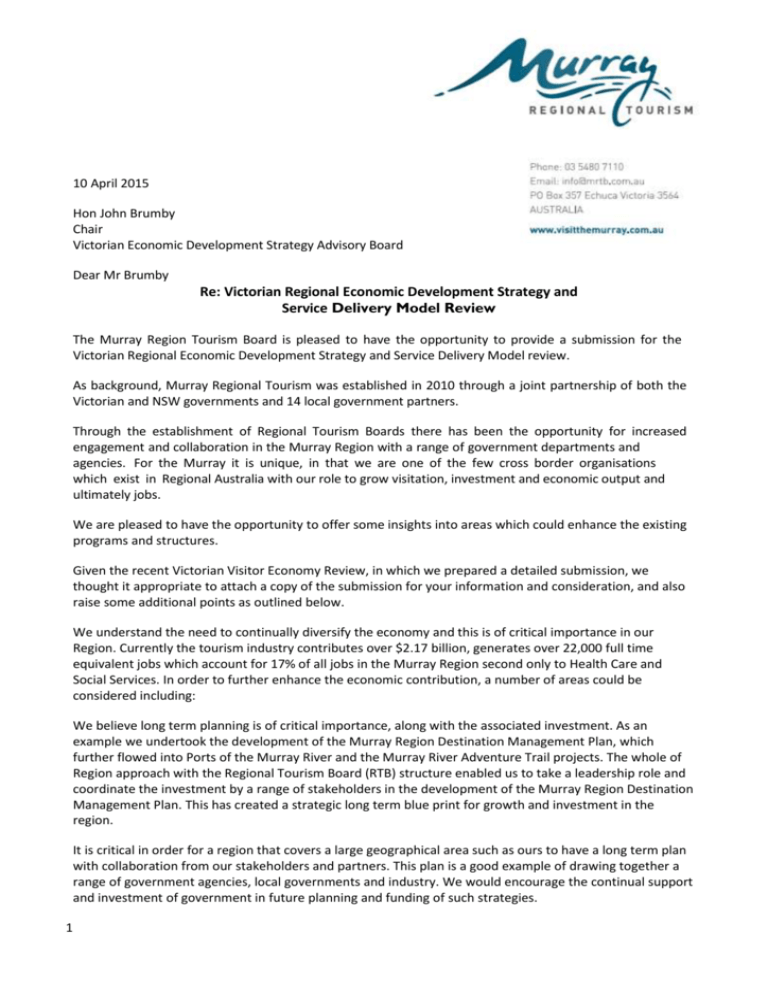
10 April 2015 Hon John Brumby Chair Victorian Economic Development Strategy Advisory Board Dear Mr Brumby Re: Victorian Regional Economic Development Strategy and Service Delivery Model Review The Murray Region Tourism Board is pleased to have the opportunity to provide a submission for the Victorian Regional Economic Development Strategy and Service Delivery Model review. As background, Murray Regional Tourism was established in 2010 through a joint partnership of both the Victorian and NSW governments and 14 local government partners. Through the establishment of Regional Tourism Boards there has been the opportunity for increased engagement and collaboration in the Murray Region with a range of government departments and agencies. For the Murray it is unique, in that we are one of the few cross border organisations which exist in Regional Australia with our role to grow visitation, investment and economic output and ultimately jobs. We are pleased to have the opportunity to offer some insights into areas which could enhance the existing programs and structures. Given the recent Victorian Visitor Economy Review, in which we prepared a detailed submission, we thought it appropriate to attach a copy of the submission for your information and consideration, and also raise some additional points as outlined below. We understand the need to continually diversify the economy and this is of critical importance in our Region. Currently the tourism industry contributes over $2.17 billion, generates over 22,000 full time equivalent jobs which account for 17% of all jobs in the Murray Region second only to Health Care and Social Services. In order to further enhance the economic contribution, a number of areas could be considered including: We believe long term planning is of critical importance, along with the associated investment. As an example we undertook the development of the Murray Region Destination Management Plan, which further flowed into Ports of the Murray River and the Murray River Adventure Trail projects. The whole of Region approach with the Regional Tourism Board (RTB) structure enabled us to take a leadership role and coordinate the investment by a range of stakeholders in the development of the Murray Region Destination Management Plan. This has created a strategic long term blue print for growth and investment in the region. It is critical in order for a region that covers a large geographical area such as ours to have a long term plan with collaboration from our stakeholders and partners. This plan is a good example of drawing together a range of government agencies, local governments and industry. We would encourage the continual support and investment of government in future planning and funding of such strategies. 1 Importance of regional development funding of small public sector projects and although difficult to link directly to jobs we believe investment by government is needed. This is important to enable infrastructure developments which create leverage opportunities for the private sector and is key to strengthen regional communities. We have seen examples in our Region of small investments in public infrastructure which has enabled further investment or in some cases strengthened existing marginal businesses to become sustainable and led to ongoing jobs and increased economic activity. Service coordination is critical and it is vital to link services across all of government. Regional Development Victoria (RDV) is a key facilitator of this and it would be important to see this role expanded. As an example, RDV are a fantastic enabler, this focus could be enhanced with greater coordination and the drawing together of areas such as Business Victoria, sport & recreation, natural resource and parks management, transport, aboriginal affairs, planning, education and training to form in region workgroups. Currently the relationship across these areas are project based and the opportunity could exist to create a more sustainable structure which encourages information sharing and partnership exploration on a more regular basis. We believe the new strategy needs to continue to create opportunities for further infrastructure investment, either through seed or feasibility funding and enabling funding of key projects. One such example for our Region is the Koondrook Wharf project. Through the provision of funding by government the project was taken from inception to feasibility and now funded for development. This is a great example of incremental investment over a relatively short time period has resulted in the development of a key initiative and enabling project being realised. A second example of a private sector success is the funding made available by the NSW Regional Visitor Economy Fund to Cadell on Murray. This is a small private sector motel that without the opportunity to access matched dollar for dollar funding would not have reinvested or created the opportunity to grow the economic output and created new jobs. The grant funding provided the stimulus for the project. These projects and many more will be critical to stimulating further investment in the Region and we urge the government to expand these opportunities that were both aligned to the Murray Region Destination Management Plan. Rate capping issues which will arise from a future infrastructure capital raising perspective. Linked to this will be a key issue with our councils being in a position for the recurrent funding of public infrastructure. Consideration will need to be given on the impediments this rate capping may place on the development of critical infrastructure projects. As an example, we have seen our NSW LGA partners struggle to progress key enabling projects such as the Moama or Tocumwal River front developments due to their inability to raise matching capital. A challenge for all of Victoria will be addressing ageing demographics; and this is a particular concern in the regions. We applaud the government for the continued efforts and media campaign actively encouraging families to relocate to the regions. While the progress to date has been successful we believe it is imperative to continue to create quality jobs, housing and education to attract young people and families to regions. The Digital Capacity of Regional Victoria will continue to be a key driver of the economy. We would ask the government to consider two key needs for the Region. The first being the need for education and training to assist with the adoption of technology and secondly, the need for increased capacity of the network. With the increase in usage of mobile devices the current infrastructure fails in regional areas and this is particularly evident in peak visitation periods. This not only is an impediment to growth, but also is a deterrent for repeat visitation. 2 Consideration of further investment in a business program for start-up enterprises and secondly business mentoring. Often business is established without full mix of skills and or expertise which can lead to failure or the unfulfilled potential of the ideas. To truly grow the regional economies we need to foster innovation and entrepreneurial spirit and this can only occur with a solid support mechanism in place. To ensure the regions thrive into the future there is the need to focus on building leadership capabilities and human capital. We would encourage the government to ensure programs and or initiatives are available to nurture this in both formal and informal programs within sectors and across industry sectors. We believe the RTB structure provides an opportunity to centralise funding to facilitate investments across a range of activities linked to the priority areas and initiatives identified in the Destination Management Plan. Consideration should be given to the engaging with the RTB for all government funding provided to business and infrastructure projects. This process to some has occurred with RDV Loddon Mallee for instance where we were consulted to determine strategic priority and alignment prior to funding. We would ask the government to consider creating a formalised structure to facilitate this process. Ability to fund and or stage projects over a longer period of time. Consider funding programs which could span multiple financial years. Example could be leadership program which can take some time to secure participants and other funding partners prior to delivery. This is not feasible within a twelve month window given industry constraints of peak visitation periods. Need for innovation and associated funding which encourages innovation in a range of areas. Consideration could be given to funding for new, innovative industries to establish in regional locations and incentives for such industries to relocate to the regions. A further opportunity is for the provision of funding for cross regional projects and sharing of resources. An example of such would be the Digital program being delivered across four regional tourism boards currently which has enabled the advancement of digital capabilities utilising the same technology solution and sharing ongoing development costs. On behalf of the Murray Region Board and our stakeholders we thank you for the opportunity to provide a submission and look forward to being actively engaged in the implementation of the new Victorian Economic Development Strategy. Kind regards Wendy Greiner Chair Murray Regional Tourism 3
